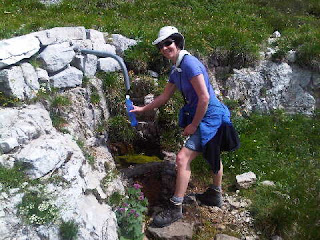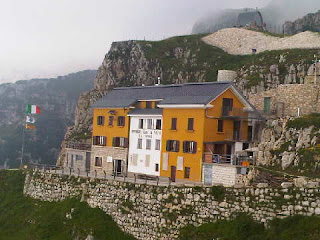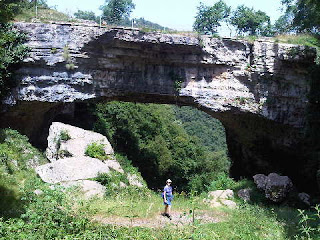

We woke at 6am to a ferocious storm, with 1cm diameter hailstones. Sue thought I was in the shower, but it was the sound of the hail against the window. It was exactly one week since we had last seen any rain - as we were setting off from Manchester. The storm woke the entire small community of Passo Coe and continued in intense pulses as we enjoyed our breakfasts.
'Perhaps it will clear the air', we hoped, as whilst we have been passing through wonderful scenery, our distant views have so far been hazy.
Claudia and Andrea were our hosts at La Stua. We lingered over breakfast until the magic time of 8am, when an important phone call could be made. Meanwhile Sue found a fine guide to the region's many orchids (ISBN: 88-7024-476-8).
The important phone call turned out not to be possible until 9am, when the local bus company's office opens. We had wanted to find out the bus times from Carbonare to Luserna. The E5 route takes to the road here, and appears to be intended to be travelled by bus. Thus E5 should be considered a 'journey' with any form of transport permissible, rather than a 'trek'. Our E5 strip map even has a picture of a bus next to the highlighted red line of the route for this section.
The storm abated as we donned what amounted to 'full winter kit', and a few seconds after our 9am departure towards Carbonare through a wet meadow with surprised deer, it stopped completely. For an hour or so. The overtrousers stayed on for some time because of the soaking undergrowth, and before we reached the large labyrinthine structure of ex Forte Cherle light rain was falling again. Both today's pictures are taken from here. The fort was part of a series of seven such structures, linked by trenches and other fortifications, and supplied by mechanised cableways from the valleys. They date from 1907 to 1915 and were built by the Austrians in anticipation of the looming military conflict with Italy. The storm had partially flooded the interior, and our torches weren't handy, so our exploration of the structure was fairly limited. Most of the fort seemed to be underground, with gun emplacements on the surface.
Shortly before reaching the fort we passed down 185 stone steps from the site of an Austrian wartime hospital. This 'emperor's staircase' was reputedly built for the visit of the heir to the throne, but became known by soldiers as the Staircase of Death.
The 'Sentiero delle Pace' commended by Markus in an earlier comment passes through here and coincided with quite a bit of our route today.
Carbonare could be seen below, between layers of cloud into which we soon immersed ourselves on the walk down to this small town, which took us three hours from Passo Coe. We saw two people all morning - poncho clad hikers ascending from Carbonare. Albergo Cornetto provided lunch, an ATM was raided, and the sun came out.
We now knew the bus times to Luserna - 1.45pm - so we'd have to wait an hour, would not start walking again until 2.30, and would probably arrive in Levico after 6.30. Given the stormy weather and the cloud cover, we decided to by-pass the official E5 route and walk directly to Levico. The distance was about the same (15km), but we could set off at 1pm.
So that's what we did, and once we had got the first half hour along the road past Virti over with, we found it to be an excellent route, though we had to play it by ear a little as the path (219/218) on our map was closed by a landslide. We went down the river that was 219 anyway and, shortly before its junction with 218, we were faced with a third and fairly definitive sign indicating the paths in that direction were closed. However, to our left path 217, unmentioned by our map, was signposted 'Val di Centa', which seemed fine. So down we went winding steeply through dense woodland, with glimpses of bare rock on the opposite side of the deep valley. At 950 metres an old stone cross bore an inscription, ending with a skull and crossbones, that was so faded it will be difficult to decipher.
Occasional squeals from disturbed chamois broke the silence, but none revealed themselves to us.
Eventually we reached the bottom of the valley, where our path crossed the infant Torrent Centa. Today it really was a torrent, and care was needed to cross a bridge of sticks without falling in.
We soon found ourselves on a nature trail - 'Parco Fluviale - Torrente Centa' - and discovered some of the interesting history of this deep valley. We passed below a huge waterfall, Cascate di Vallampach, and the remains of a large mansion, Case More, that was abandoned in 1913, as well as much more of interest.
Although not marked on our map, the path was clearly signed (curiously in kilometres rather than in hours, the latter being the norm here) to Caldonazzo, near where we picked up a horse trail towards Posto Tappa Lochere, before which a final turn to the left took us into Levico Terme a little over four hours after leaving Carbonare.
I'm sure that the E5 route has its merits, but the bus timetable is not ideal. For us it would have meant a latish arrival in Levico (though our concern about ongoing stormy weather swayed our decision to descend from Carbonare), whilst those walking in the 'correct' direction from Levico would need a very early start to walk for nearly 5 hours to Luserna in time for the bus to Carbonare that leaves soon after noon. It may be better for those folk to take their time, catch
the later bus, and spend the evening at Carbonare rather than press on to Passo Coe.
Readers may have worked out that we are based in Levico for a short rest. Hotel Ideal is ... ideal, and we had time to enjoy a concert from an excellent Viennese ensemble last night. We were possibly the only native English speakers in the audience. We haven't seen anyone whose native language is English since we left Verona, although many of the information boards we have passed are printed in Italian, German and English.
Comments:
Jules - there are certain points in the Alps that are more 'on the map' than others. So far, this route passes through the latter. These are the 'Piccole Dolomiti', they have all the features, apart from the height, of the more familiar Brenta and the massifs near Cortina and Corvara. There's a huge network of paths and tracks, and lots of historical interest. Wonderful flora as well, as you may have gathered.
Alan R - unusually, Rif Lancia put each of the three couples into different dormitories, so we never did discover whether anyone snored. It was a spotless place, so very good of them to give themselves three rooms to clean rather than one, although it has to be said we left them very little work.
Nick - your comment came through just as we were drying out in Carbonare. However, we'll settle for two hours of rain a week! It's good to hear from you and it would be great to meet up towards the end of our trip if you have the time (dinner in Constance on 5 August?). You'll see that I've planned a little trip into the Lechtalalps, it'll bring back memories of our 1980 trip perhaps. Feel free to join us...
Data:
6 July 2012
25km in 8.5 hours with 400m ascent
(Cum: 117km with 6550m ascent)
Other E5 walkers - none in evidence
Flower of the Day - Sowbread (Cyclamen purpurascens)
Rain seen since leaving Timperley - one ferocious mountain storm
Itinerary - http://www.topwalks.com/E5%20Route.html
Sent using BlackBerry® from Orange


















